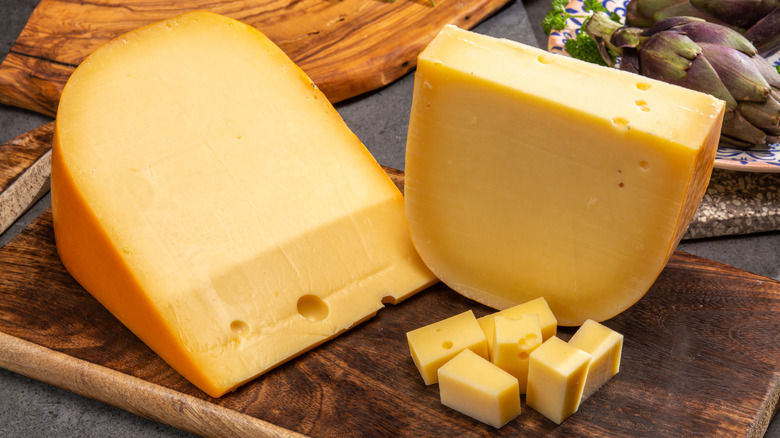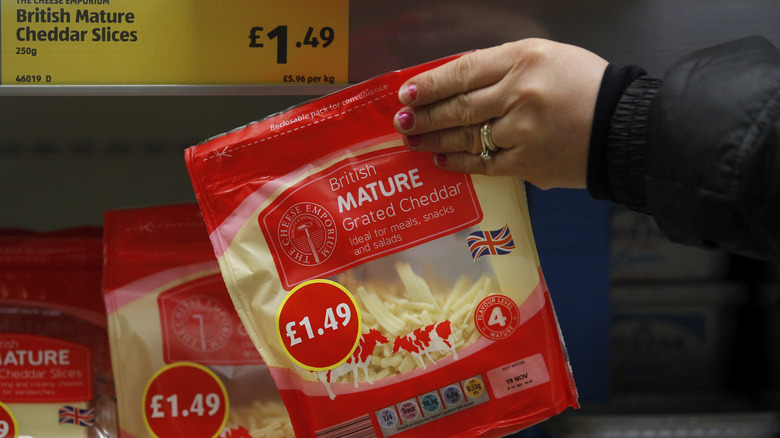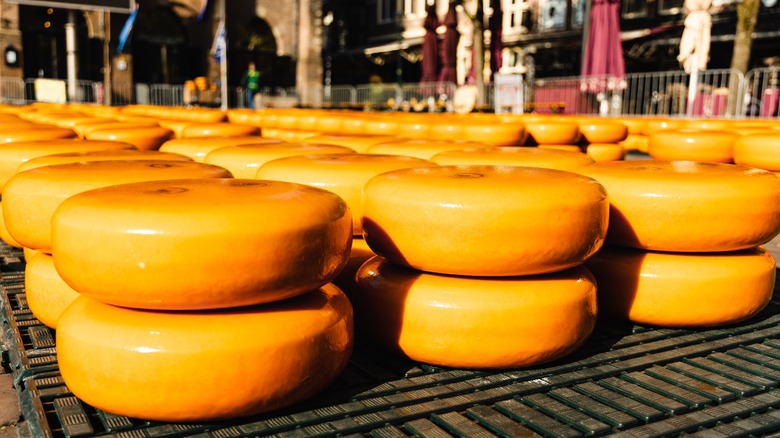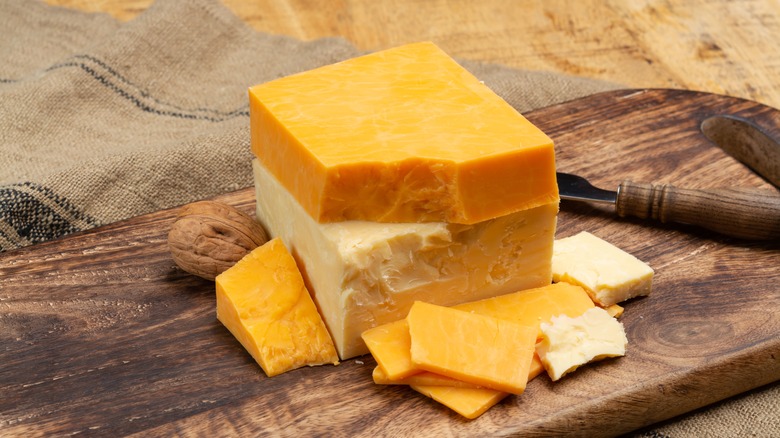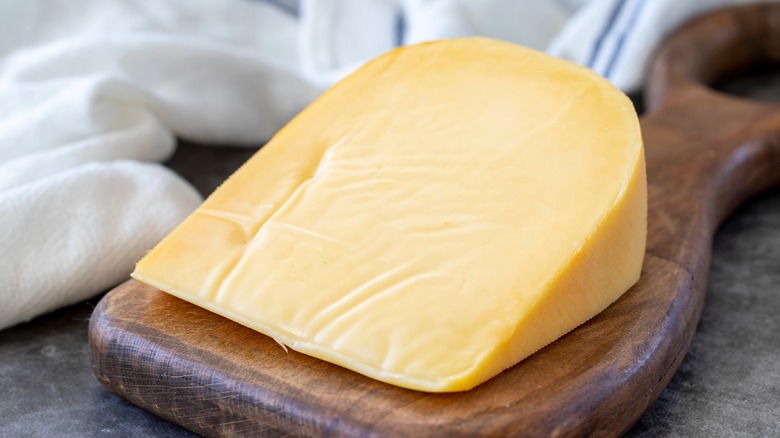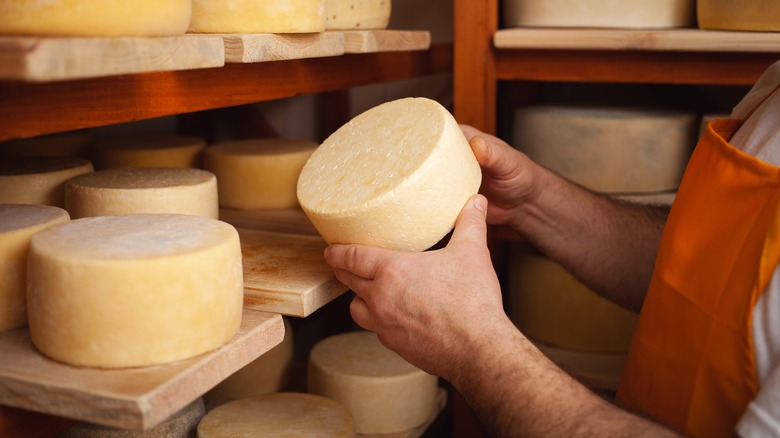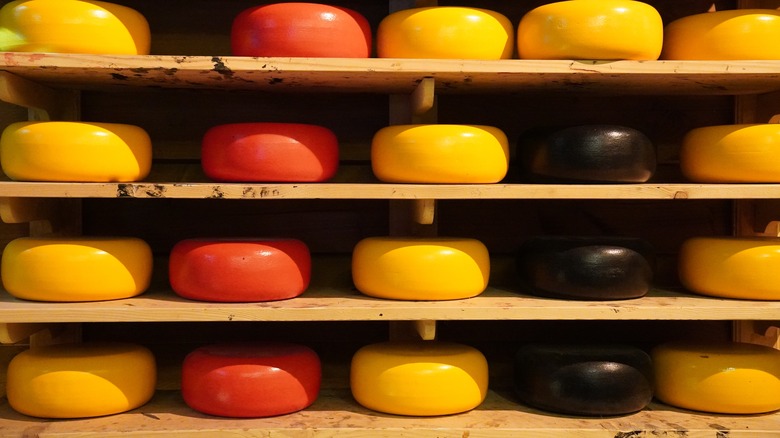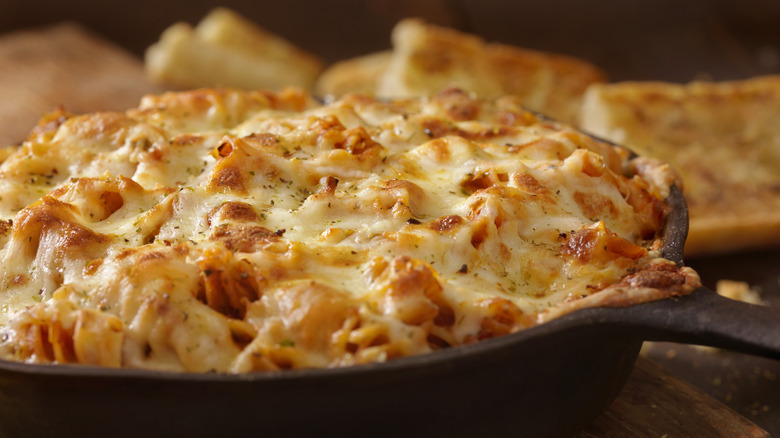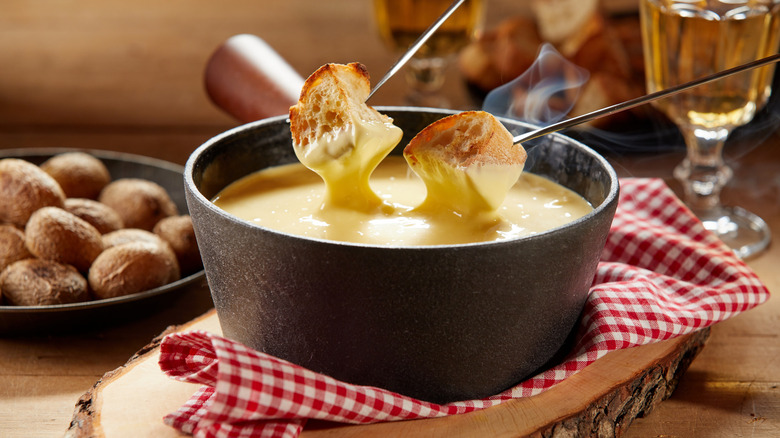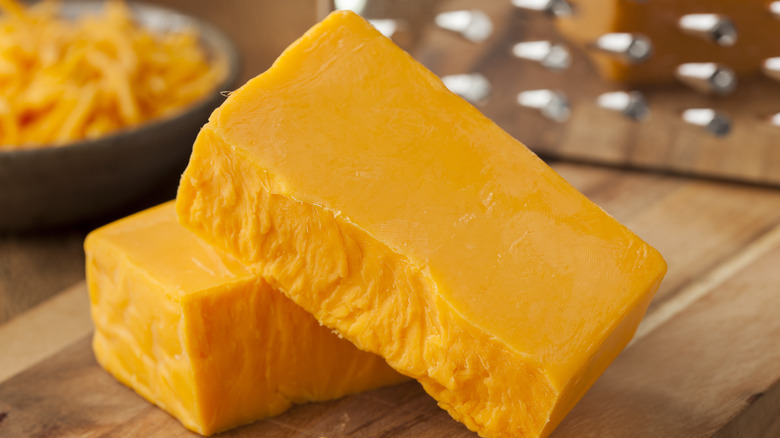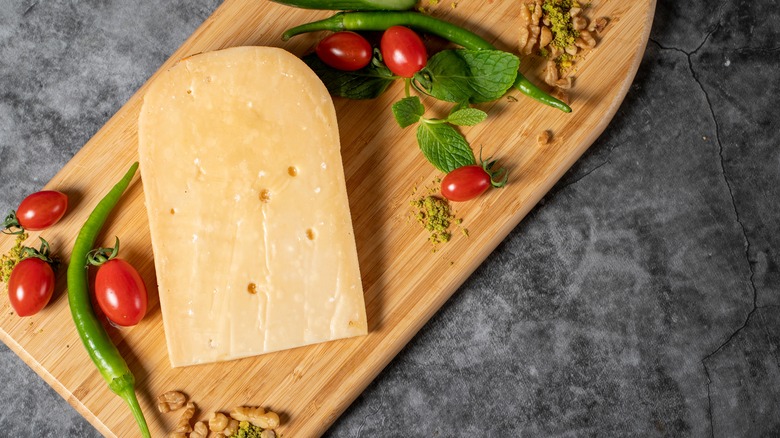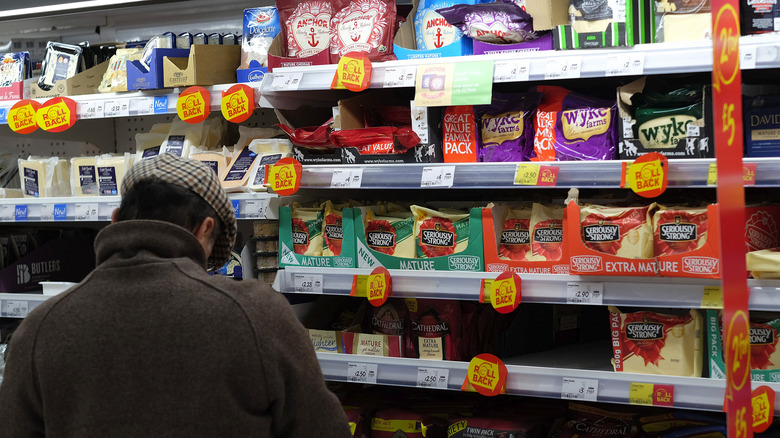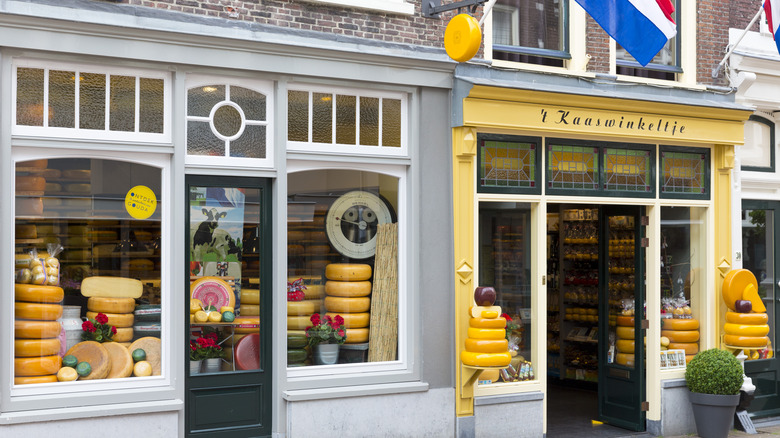Cheddar Vs Gouda: Everything You Need To Know
You've just scheduled an at-home date night with your significant other and have decided that a cheese board is in the cards. But when you get to the cheese aisle to procure the main ingredient, there is a dizzying array of options, many of which are hard to tell apart. Take cheddar and Gouda, for example. Cheddar is ubiquitous. It's found in everything from chili to biscuits and is frequently employed in snack foods. Then, there's Gouda. With its red wax wrapper and capitalized "G," it just looks more sophisticated, even though, when it comes to the actual cheese part, it looks pretty identical to cheddar.
As their similar appearances suggest, cheddar and Gouda can often be used interchangeably in recipes, and they boast broadly appealing flavors. But, in the same way that goat cheese and feta bear some resemblances but are ultimately worlds apart, there are enough differences between cheddar and Gouda to make them best suited for different occasions. One is sweeter and nuttier, while the other is sharper and more savory. They come from different parts of the world and have different production processes. Their prices vary, as do their textures. When it comes right down to it, they are two entirely different products. For cheese lovers, it's worth knowing the differences so that the next time you're planning a gourmet cheese board or a quick turkey sandwich, you'll know exactly which one will suit the moment.
Cheddar was created in England
Despite the integral role it plays in many of our lives, cheddar cheese has not been around since the beginning of time. Not even the great thinkers in Ancient Greece or the Roman Empire got to enjoy its singular flavor. Its origins can be traced back to the 1100s, to a small English village that bears its name. Cheddar is known for its caves and gorges where farmers preserved fresh milk during warm weather. There is no definitive account of who created the world-famous cheese, but the legend holds that a milkmaid left a bucket of milk in a cave for longer than usual, and discovered that it turned into a deliciously sharp substance that was safe to eat.
Whatever its precise origin story, cheddar was quickly recognized as a desirable (even indispensable) product. King Henry II was such a big fan of the stuff that he took his mind off reigning England and much of Wales, Ireland, Scotland, and France to prioritize the purchase of more than 10,000 pounds of it in 1170. A few centuries later, it was in such high demand that it was only available at the palace of King Charles I.
Gouda is from the Netherlands
Gouda also gets its name from a small village, but one that's in Holland rather than England. Unlike Cheddar, however, the northern town of Gouda is not believed to have been the origin of its cheesy namesake. In fact, Gouda (the cheese) is not as geographically specific as its name suggests. It has been made throughout parts of the Netherlands since the 12th century, and its association with a specific town is likely the result of a quirk in Medieval trading laws rather than where it was initially produced.
In the 1300s, Dutch cities had to apply for the right to sell specific goods, and Gouda happened to win the right to sell the cheese made in its county. Farmers from the area had to bring their goods to the town of Gouda in order to sell them, eventually establishing a renowned cheese market. Consequently, it became the place associated with that particular style of cheese.
Cheddar is produced around the world
Since its humble beginnings in a small English village, cheddar has become a superstar of the cheese kingdom, and the U.S. is one of its most voracious markets. It was the most popular cheese in the country almost every year between 1995 and 2009, and is now second only to mozzarella. According to data collected by the U.S. Department of Agriculture, Americans have been eating about 11 pounds of cheddar per capita every year since 2017.
Given this demand, it's not surprising that cheddar cheese is one of the most widely produced dairy products in the world. In the U.S., it's made predominantly in New York, Wisconsin, Vermont, and California, while around the globe, large producers include Canada, the U.K., and New Zealand. Given this geographical breadth, it's not surprising that cheddar styles vary depending on the region in which it is produced. Cheddar produced in the U.S. must be a minimum of 50% milkfat by weight of the solids, according to the U.S. Food and Drug Administration, but while New England cheddar tends to have a sharp flavor and firm texture, Wisconsin cheddar tends to be sweeter and softer. Meanwhile, British cheddar is known for its crumbly texture.
Gouda has origin protection from the European Union
While cheddar cheese can be made pretty much anywhere, Gouda has a more complicated relationship with regulation. Technically, it doesn't have to be made in Holland or even within Europe. There are manufacturers in the U.S. and Canada that produce Gouda, adopting the same style as the Dutch but without having to adhere to specific types of milk. If you go to a grocery store and find a cheese labeled as Gouda, there is no guarantee that it has anything to do with the Dutch cheese aside from the name and general flavor.
In the European Union, however, there are stringent rules. For a cheese to be sold as "Gouda Holland," it must be naturally matured and made from the milk of cows from Dutch dairy farms. For a cheese to be sold as "Noord-Hollandse Gouda," the rules are even stricter. Noord-Hollandse is the province where the cheese originated and has a special claim over its manufacturing process. These products must be made from milk produced only within the province. To experience Gouda that tastes as close to the Medieval variety as possible, opt for a Noord-Hollandse variety.
Cheddar has a sharp flavor and firm texture
There's a reason cheddar cheese is so beloved by consumers around the world. Its sharp, umami flavor varies depending on the variety, but it is distinctive compared to other cheeses. Mild cheddar is buttery and perfect for adding to a sandwich when you don't want it to overpower the other ingredients. On the other end of the spectrum, sharp cheddar has a powerful kick that cuts through other flavors despite its creamy texture. For those who can't quite decide, medium cheddar is the perfect balance.
In contrast with cheeses like Brie and Camembert, cheddar has a hard texture that grows more crumbly as it ages. This makes it an obvious option for recipes that call for shredded cheese because it doesn't turn to mush when it comes in contact with a grater. To make it even more of a crowd-pleaser, it doesn't have the funky flavor possessed by many other cheeses (we're thinking particularly of the French ones here). Salty, lightly tangy, and with a stretchy texture when melted, it is the go-to option for many cooks and a safe choice when you're not sure about your guests' preferences.
Gouda has a creamy flavor and softer texture
At first glance, Gouda is similar to cheddar. It is usually sold in the same pale yellow wedges and appears to have the same firm texture. However, once you taste it, the differences are clear. Gouda has a softer, creamier texture and a flavor that is sweeter and nuttier than cheddar. Because of its sweetness, this cheese doesn't fit into recipes in the same way as its tangier cousin. Cheddar has an umami flavor that makes it largely incompatible with sweet recipes, but Gouda can taste delicious when added to desserts like cheesecake, and eaten with sugary fruits like pears and dried apricots.
Like all cheeses, Gouda gets stronger as it ages, developing a more intense flavor that has a light tanginess and even hints of spiciness. Unlike cheddar, however, its sweetness also deepens, developing decadent caramel notes that are tough to find in other cheeses. When pairing Gouda with alcohol, the sweet nuttiness and light tanginess of an aged variety are suited to the rich chocolatey character of stout beers and fruity, robust red wines.
Cheddar is aged between two months and several years
Most cheeses begin with an enzyme called rennet that curdles milk to create curds and whey. The curds are then used to make the cheese. Cheddar traditionally undergoes a unique process known, appropriately enough, as "cheddaring." During this period, the curd is sliced into slabs, stacked, and turned periodically, draining some of its moisture and allowing it to develop acidity that is crucial to its trademark tangy flavor. Cheddaring has been replaced with industrialized compression and draining equipment, but some producers still employ the method for a more traditional product. Once the curds have been drained and acidified, they are pressed into molds and left to age. Mild cheddar is younger, having aged for as little as three months, while sharp cheddar generally takes up to 18 months. Some specialty cheddars that are not sold at major grocery stores can be aged for several years.
One aspect of cheddar that does not hinge on aging is color. Whether a block of cheese is orange or pale yellow has nothing to do with time but with food coloring (annatto, the seed from achiote trees, is the traditional source for coloring). Why producers started coloring cheddar is up for debate, but many believe that it began centuries ago as a way to signify quality. Grass-fed cows produce milkfat that has a slight golden hue due to the beta-carotene in grass, which supposedly suggests healthy cows, and therefore high-quality milk.
Gouda is aged between one month and four years
The production process of Gouda begins like cheddar by introducing rennet to milk to create curds and whey. Instead of stacking and turning the curds to remove moisture and encourage acid development, however, producers wash them to remove as much lactose as possible. At first glance, this seems counterintuitive. Lactose is a naturally occurring sugar in milk, and given that Gouda is known for its sweet flavor, you'd think manufacturers would want as much of it as possible. But as the curds slowly turn to cheese, the lactose transforms into lactic acid, providing a sharp flavor that is perfect for cheddar but in direct opposition to the sweetness of Gouda.
Once the curds are washed, they are pressed into wheel-shaped molds and soaked in brine to deepen the cheese's flavor and repel bacteria. Then, they are covered in wax and left to age. Gouda is a younger cheese than sharp cheddar, with a minimum aging period of one month. Some producers experiment with longer aging, sometimes up to four years, but most of the options that you'll find at a typical supermarket will be somewhere between four and 12 months old.
Cheddar is one of the most versatile culinary cheeses
Between its sharp flavor and creamy, stringy texture, cheddar is a natural fit for a dizzying range of recipes. To showcase the ingredient, you can't go wrong with a classic grilled cheese or homestyle mac and cheese. In these recipes, it melts into an ooey gooey mess of salty deliciousness. In soups, it melts into an elastic texture bursting with umami flavor, transforming a healthy recipe like broccoli soup into a velvety, decadent crowd-pleaser that even veggie-averse kids will be begging for. If you sprinkle it on top of biscuits and casseroles, it becomes crispy, forming a salty crust that melts in your mouth as you chew.
You don't have to limit cheddar to lunch and dinner recipes either. It plays a key role in a copycat Starbucks breakfast sandwich, for example, and you can even add it to waffles and savory overnight oats. Whether you're whipping up a quick sandwich or planning an extravagant main dish, cheddar is one of the most reliable and delicious additions.
Gouda is often used for melting
Although Gouda is not featured in recipes as frequently as cheddar, it is just as versatile. Instead of offering tanginess or a crispy crust, it provides a subtly sweet, nutty creaminess. Whether you're melting it or adding it to a cold sandwich, Gouda provides a delicious alternative to cheddar when you're looking for a softer flavor and rich texture. Gouda is frequently found in smooth, creamy recipes due to its unique melting qualities. While cheddar becomes stringy when melted, Gouda turns to a thick, smooth texture, making it perfect for fondue and mac and cheese. It also has a slightly lower melting point of about 130 F, especially when it's a younger cheese. In contrast, cheddar melts at around 150 F. If you want a buttery smooth melted cheese, this Dutch classic is hard to beat.
Gouda is also an ideal choice for cheese boards, especially those containing fruit and jam. Because of its sweetness and the caramel notes that develop in older varieties, it is a perfect complement to the floral fruitiness of grapes, pears, melon, and even honey.
Cheddar has lots of saturated fat and a few nutrients
Reading the nutrition labels on cheese can be a bit disheartening, but we're here to provide a holistic perspective on two of the most delicious options on the market, and luckily, it's not all doom and gloom. Let's start with the bad news. Cheddar has a lot of fat. A 1-inch cube of sharp cheddar contains about 30% of the recommended daily value of saturated fat and about 10% of the recommended daily intake of cholesterol. Cheddar also tends to have a lot of sodium, which, although a vital nutrient, can cause high blood pressure and increase the risks of heart attacks and strokes if consumed in large quantities. A 1-inch cube of cheddar typically contains about 9% of the recommended daily intake of sodium, which is not ideal considering that almost every other food we eat provides salt as well.
On the positive side, the same small portion of cheddar offers about 7 grams of protein, almost 14% of the 50 grams that the FDA recommends consuming each day. It also provides about 15% of the recommended intake of calcium, which is a crucial nutrient for strengthening bones. Last but not least, cheddar is an excellent source of selenium, a trace mineral that is involved in reproduction, hormone functioning, and metabolism along with protecting DNA and cells from damage. A 1-inch cube of the cheese contains about 52% of the recommended daily amount.
Gouda has fewer calories
Sadly, the nutritional profile of Gouda is not much better than cheddar's, though it too has a few saving graces. It contains about the same amount of fat as cheddar but has fewer calories (around 100 for a 1-inch cube compared with about 114 in cheddar). This may be due to the slightly higher moisture content in Gouda. Density is unlikely to be a cause since the caloric discrepancy is still present when comparing the cheeses by weight rather than volume.
Gouda is usually just as packed with sodium as cheddar, with a 1-inch cube containing around 10% of the recommended daily value. All these metrics change, however, depending on how much aging the product has undergone. Young Gouda has fewer calories, while a variety that has been aged for 18 months might have 120 calories per 1-inch cube, along with slightly more fat and protein.
Like cheddar, Gouda provides a hefty dose of calcium, as do all milk-based cheeses. One health benefit that you won't find on nutrition labels, however, is probiotics. Certain cheeses, including Gouda, cheddar, and Swiss cheese, contain the kind of bacteria that improve gut health, though not enough to outweigh their nutritional downsides.
Cheddar ranges in price
Because of its broad appeal, cheddar is easy to get and relatively cheap compared to specialty cheeses. It also comes in many forms, from white, crumbly blocks to bags of orange shreds and sandwich-ready slices. You can choose between mild, medium, sharp, aged, and extra-aged. There are even smoked and flavored versions.
This makes it difficult to pinpoint exactly how much cheddar costs. Depending on the product, you might pay less than $3 for an 8-ounce block of Kraft Mild Cheddar Cheese, or $9 for a 5-ounce block of Wisconsin-made, cave-aged cheddar. In the mid-range is Kerrygold's Reserve Cheddar, which is made from grass-fed cows, aged for two years, and costs around $6 for 7 ounces. Although there is variation in price depending on the production and source ingredients of a product, cheddar is one of the most affordable cheeses on the market, even when you're purchasing the top end of the range.
Gouda is comparatively expensive
Gouda is not as ubiquitous as cheddar. Head to the cheese aisle of your local supermarket and you'll be lucky to find three varieties, let alone the entire section that is probably devoted to cheddar. Your options will depend on which store you're in. A higher-end establishment that prides itself in upscale, artisanal fare may offer a wider range of Dutch Goudas, while a run-of-the-mill supermarket chain might carry one or two young, domestically produced options.
At Walmart, you can get an 8-ounce block of it for about $2, though there is little information about how or where it is made. For something that more closely resembles classic Gouda with all its depth of flavor and texture, you will end up paying several times as much. Even the Wisconsin-produced version from Whole Foods' 365 brand costs more than double the Walmart option, while an 8-ounce wedge from Holland sold under the Boar's Head brand costs over $8. If you want to go all-out on authenticity and purchase an E.U.-vetted Noord-Hollandse Gouda, you might want to start putting aside some cash. For 8 ounces of a four-year double-aged Gouda, you'll have to pay about $26.
